key TOYOTA YARIS HYBRID 2014 Owners Manual
[x] Cancel search | Manufacturer: TOYOTA, Model Year: 2014, Model line: YARIS HYBRID, Model: TOYOTA YARIS HYBRID 2014Pages: 464, PDF Size: 23.4 MB
Page 2 of 464

TABLE OF CONTENTS2
For your information .......................6
Reading this manual.....................10
How to search ..............................11
Pictorial index ...............................12
1-1. For safe use
Before driving.......................28
For safety drive ....................30
Seat belts .............................32
SRS airbags.........................39
Airbag manual on-off sys-
tem.................................... 50
Safety information for chil-
dren....................................52
Child restraint systems ........53
Installing child restraints ......63
Exhaust gas precautions .....72
1-2. Hybrid system
Hybrid system features ........73
Hybrid system precautions ..77
1-3. Theft deterrent system
Immobilizer system ..............82
Double locking system .........87
2. Instrument cluster
Warning lights and indica-
tor.......................................90
Gauges and meters .............95
Multi-information display ......98
Energy monitor/consumption
screen ..............................1023-1. Key information
Keys .................................. 108
3-2. Opening, closing and locking
the doors
Side doors ......................... 120
Back door .......................... 126
Smart entry & start system 132
3-3. Adjusting the seats
Front seats ........................ 147
Rear seats ......................... 149
Head restraints .................. 152
3-4. Adjusting the steering wheel
and mirrors
Steering wheel .................. 154
Inside rear view mirror....... 156
Outside rear view mirrors .. 158
3-5. Opening and closing the win-
dows
Power windows ................. 161
1For safety and security
2Instrument cluster
3Operation of each compo-
nent
Page 4 of 464

TABLE OF CONTENTS4
6-1. Using the air conditioning sys-
tem and defogger
Automatic air conditioning sys-
tem...................................260
Seat heaters ......................269
6-2. Using the interior lights
Interior lights list .................271
• Interior light ....................271
• Personal lights ...............272
6-3. Using the storage features
List of storage features ......273
• Glove box ......................274
• Cup holders ...................275
• Bottle holders ................276
• Auxiliary box ..................276
Luggage compartment fea-
tures.................................277
6-4. Using the other interior fea-
tures
Other interior features ........280
• Sun visors ......................280
• Vanity mirrors ................280
• Portable ashtray ............281
• Cigarette lighter .............281
• Power outlet ..................282
• Armrest ..........................283
• Panoramic roof shade ...283
• Assist grips ....................2847-1. Maintenance and care
Cleaning and protecting the
vehicle exterior ................ 286
Cleaning and protecting the
vehicle interior ................. 289
7-2. Maintenance
Maintenance requirements 292
7-3. Do-it-yourself maintenance
Do-it-yourself service precau-
tions ................................ 295
Hood.................................. 298
Positioning a floor jack ...... 300
Engine compartment ......... 302
12-volt battery ................... 309
Tires .................................. 315
Tire inflation pressure........ 328
Wheels .............................. 330
Air conditioning filter .......... 333
Wireless remote control/elec-
tronic key battery............. 335
Checking and replacing
fuses................................ 339
Light bulbs ......................... 344
6Interior features7Maintenance and care
Page 5 of 464
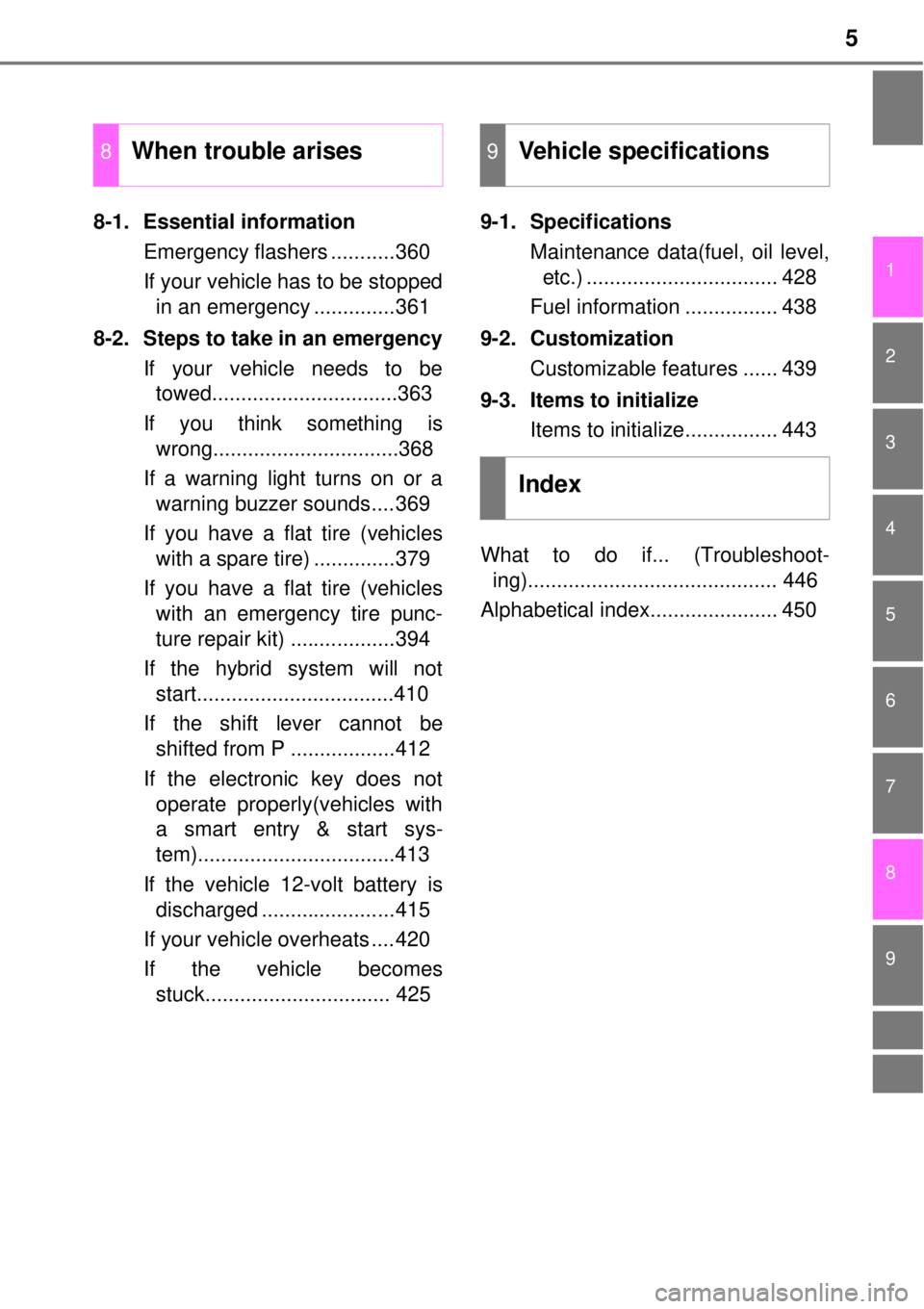
5
1
7
8 6 5
4
3
2
9
8-1. Essential information
Emergency flashers ...........360
If your vehicle has to be stopped
in an emergency ..............361
8-2. Steps to take in an emergency
If your vehicle needs to be
towed................................363
If you think something is
wrong................................368
If a warning light turns on or a
warning buzzer sounds....369
If you have a flat tire (vehicles
with a spare tire) ..............379
If you have a flat tire (vehicles
with an emergency tire punc-
ture repair kit) ..................394
If the hybrid system will not
start..................................410
If the shift lever cannot be
shifted from P ..................412
If the electronic key does not
operate properly(vehicles with
a smart entry & start sys-
tem)..................................413
If the vehicle 12-volt battery is
discharged .......................415
If your vehicle overheats ....420
If the vehicle becomes
stuck................................ 4259-1. Specifications
Maintenance data(fuel, oil level,
etc.) ................................. 428
Fuel information ................ 438
9-2. Customization
Customizable features ...... 439
9-3. Items to initialize
Items to initialize................ 443
What to do if... (Troubleshoot-
ing)........................................... 446
Alphabetical index...................... 450
8When trouble arises9Vehicle specifications
Index
Page 9 of 464

9
WARNING
General precautions while driving
Driving under the influence: Never drive your vehicle when under the influ-
ence of alcohol or drugs that have impaired your ability to operate your vehi-
cle. Alcohol and certain drugs delay reaction time, impair judgment and
reduce coordination, which could lead to an accident that could result in
death or serious injury.
Defensive driving: Always drive defensively. Anticipate mistakes that other
drivers or pedestrians might make and be ready to avoid accidents.
Driver distraction: Always give your full attention to driving. Anything that
distracts the driver, such as adjusting controls, talking on a cellular phone or
reading can result in a collision with resulting death or serious injury to you,
your occupants or others.
General precaution regarding children’s safety
Never leave children unattended in the vehicle, and never allow children to
have or use the key.
Children may be able to start the vehicle or shift the vehicle into neutral.
There is also a danger that children may injure themselves by playing with
the cigarette lighter, the windows, the panoramic roof shade, or other fea-
tures of the vehicle. In addition, heat build-up or extremely cold tempera-
tures inside the vehicle can be fatal to children.
Page 12 of 464
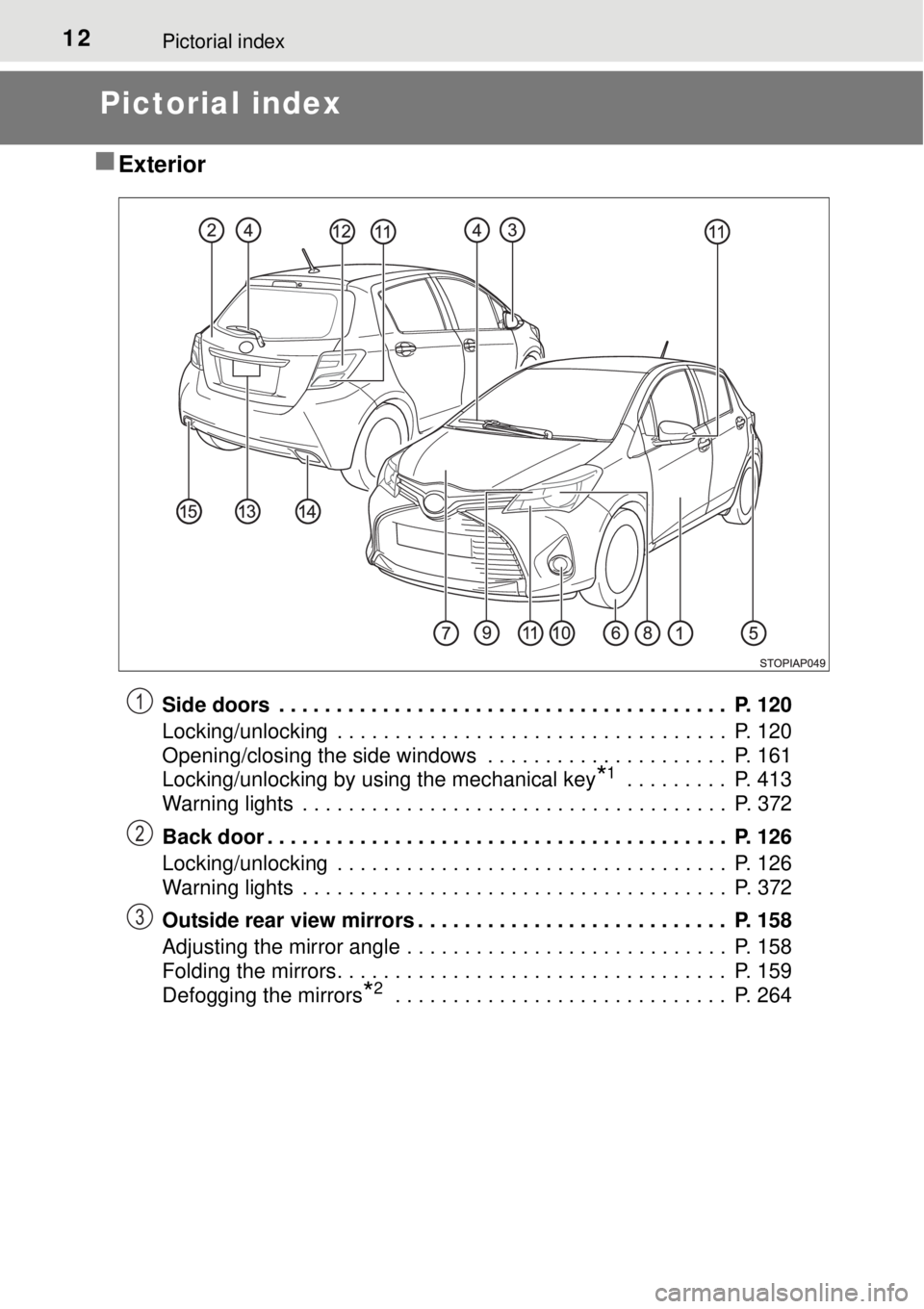
12Pictorial index
Pictorial index
Exterior
Side doors . . . . . . . . . . . . . . . . . . . . . . . . . . . . . . . . . . . . . . . P. 120
Locking/unlocking . . . . . . . . . . . . . . . . . . . . . . . . . . . . . . . . . . P. 120
Opening/closing the side windows . . . . . . . . . . . . . . . . . . . . . P. 161
Locking/unlocking by using the mechanical key
*1 . . . . . . . . . P. 413
Warning lights . . . . . . . . . . . . . . . . . . . . . . . . . . . . . . . . . . . . . P. 372
Back door . . . . . . . . . . . . . . . . . . . . . . . . . . . . . . . . . . . . . . . . P. 126
Locking/unlocking . . . . . . . . . . . . . . . . . . . . . . . . . . . . . . . . . . P. 126
Warning lights . . . . . . . . . . . . . . . . . . . . . . . . . . . . . . . . . . . . . P. 372
Outside rear view mirrors . . . . . . . . . . . . . . . . . . . . . . . . . . . P. 158
Adjusting the mirror angle . . . . . . . . . . . . . . . . . . . . . . . . . . . . P. 158
Folding the mirrors. . . . . . . . . . . . . . . . . . . . . . . . . . . . . . . . . . P. 159
Defogging the mirrors
*2 . . . . . . . . . . . . . . . . . . . . . . . . . . . . . P. 264
1
2
3
Page 34 of 464
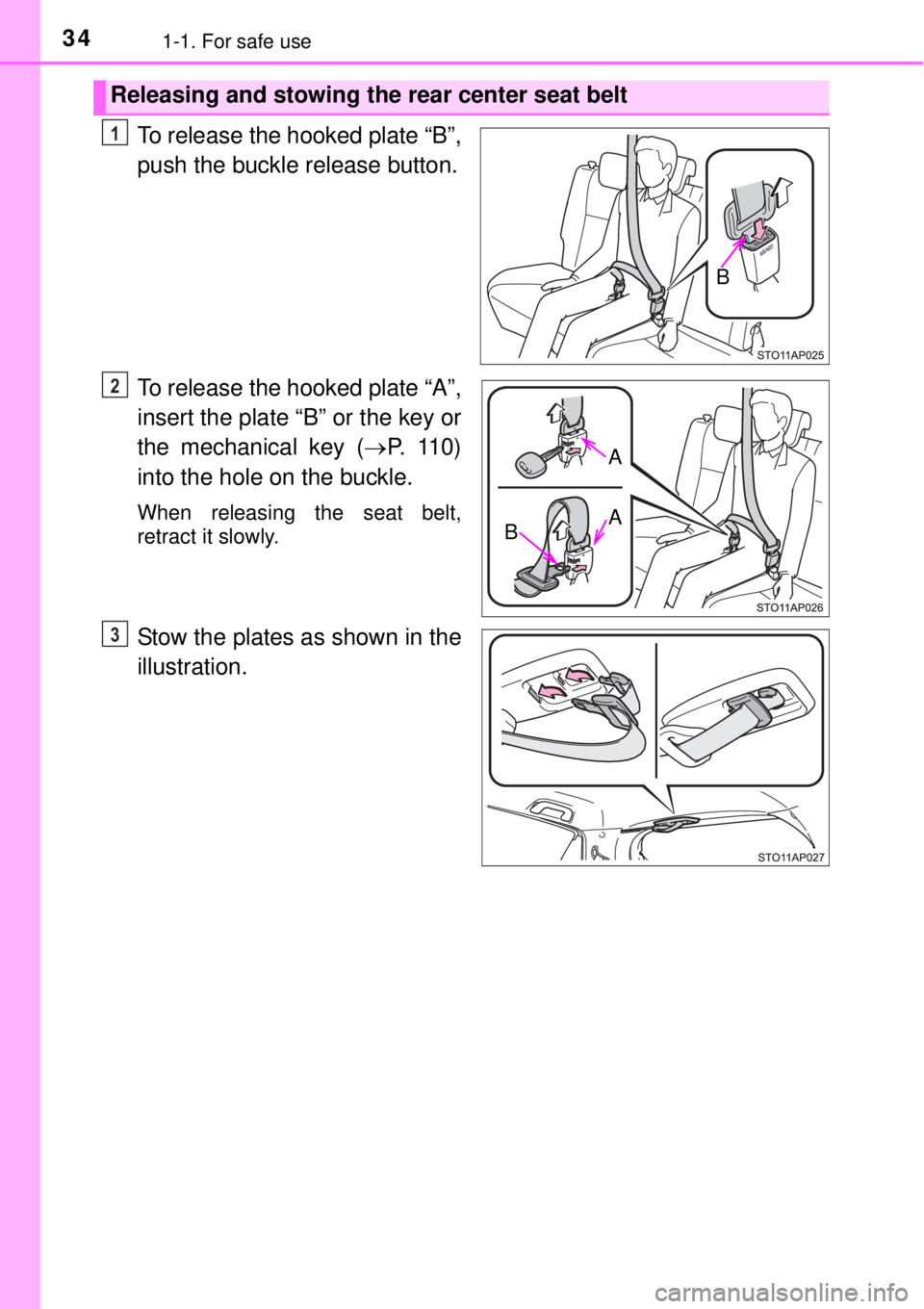
341-1. For safe use
To release the hooked plate “B”,
push the buckle release button.
To release the hooked plate “A”,
insert the plate “B” or the key or
the mechanical key (P. 1 1 0 )
into the hole on the buckle.
When releasing the seat belt,
retract it slowly.
Stow the plates as shown in the
illustration.
Releasing and stowing the rear center seat belt
B
1
B
A
A
2
3
Page 43 of 464
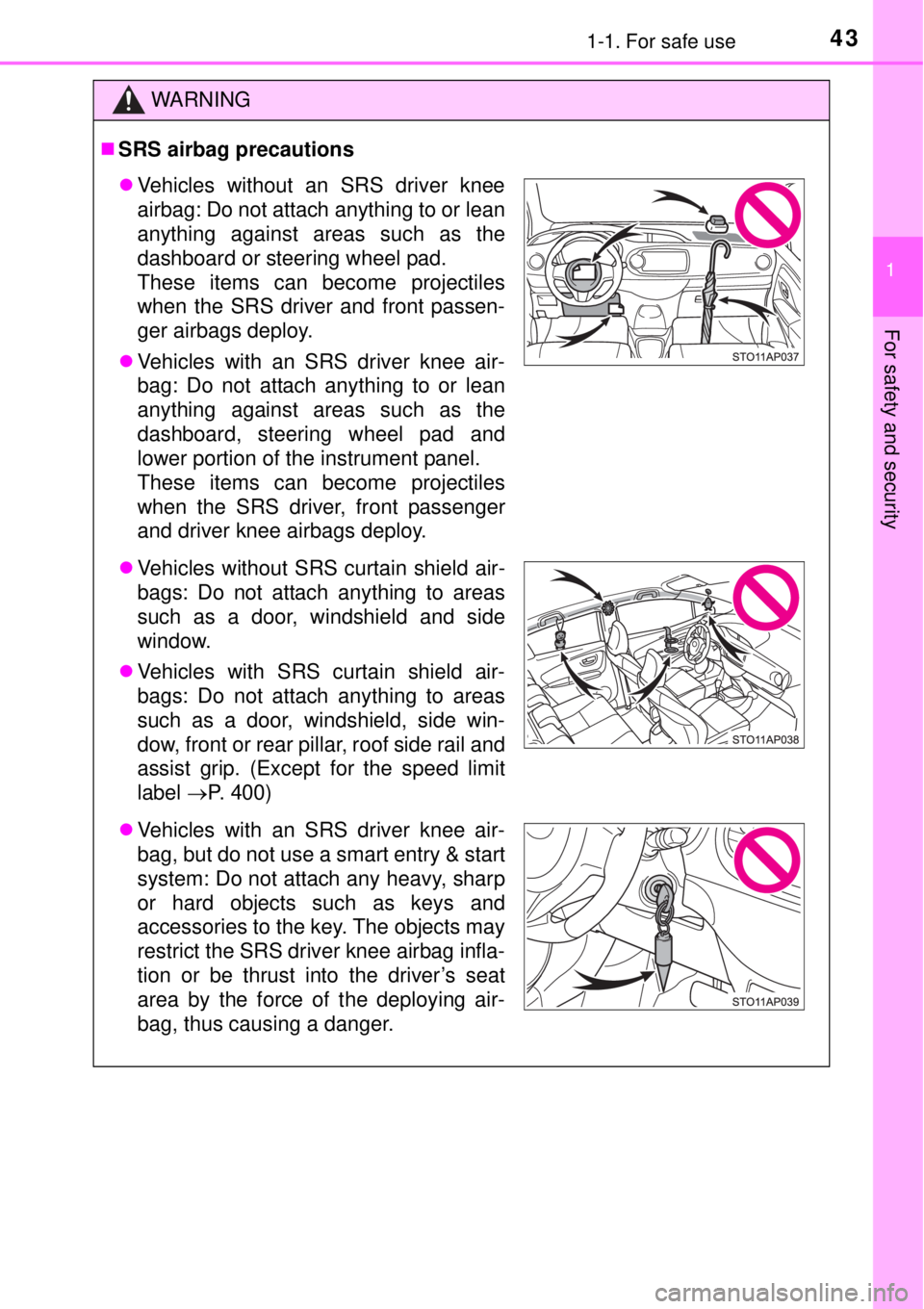
431-1. For safe use
1
For safety and security
WARNING
SRS airbag precautions
Vehicles without an SRS driver knee
airbag: Do not attach anything to or lean
anything against areas such as the
dashboard or steering wheel pad.
These items can become projectiles
when the SRS driver and front passen-
ger airbags deploy.
Vehicles with an SRS driver knee air-
bag: Do not attach anything to or lean
anything against areas such as the
dashboard, steering wheel pad and
lower portion of the instrument panel.
These items can become projectiles
when the SRS driver, front passenger
and driver knee airbags deploy.
Vehicles without SRS curtain shield air-
bags: Do not attach anything to areas
such as a door, windshield and side
window.
Vehicles with SRS curtain shield air-
bags: Do not attach anything to areas
such as a door, windshield, side win-
dow, front or rear pillar, roof side rail and
assist grip. (Except for the speed limit
label P. 400)
Vehicles with an SRS driver knee air-
bag, but do not use a smart entry & start
system: Do not attach any heavy, sharp
or hard objects such as keys and
accessories to the key. The objects may
restrict the SRS driver knee airbag infla-
tion or be thrust into the driver’s seat
area by the force of the deploying air-
bag, thus causing a danger.
Page 51 of 464
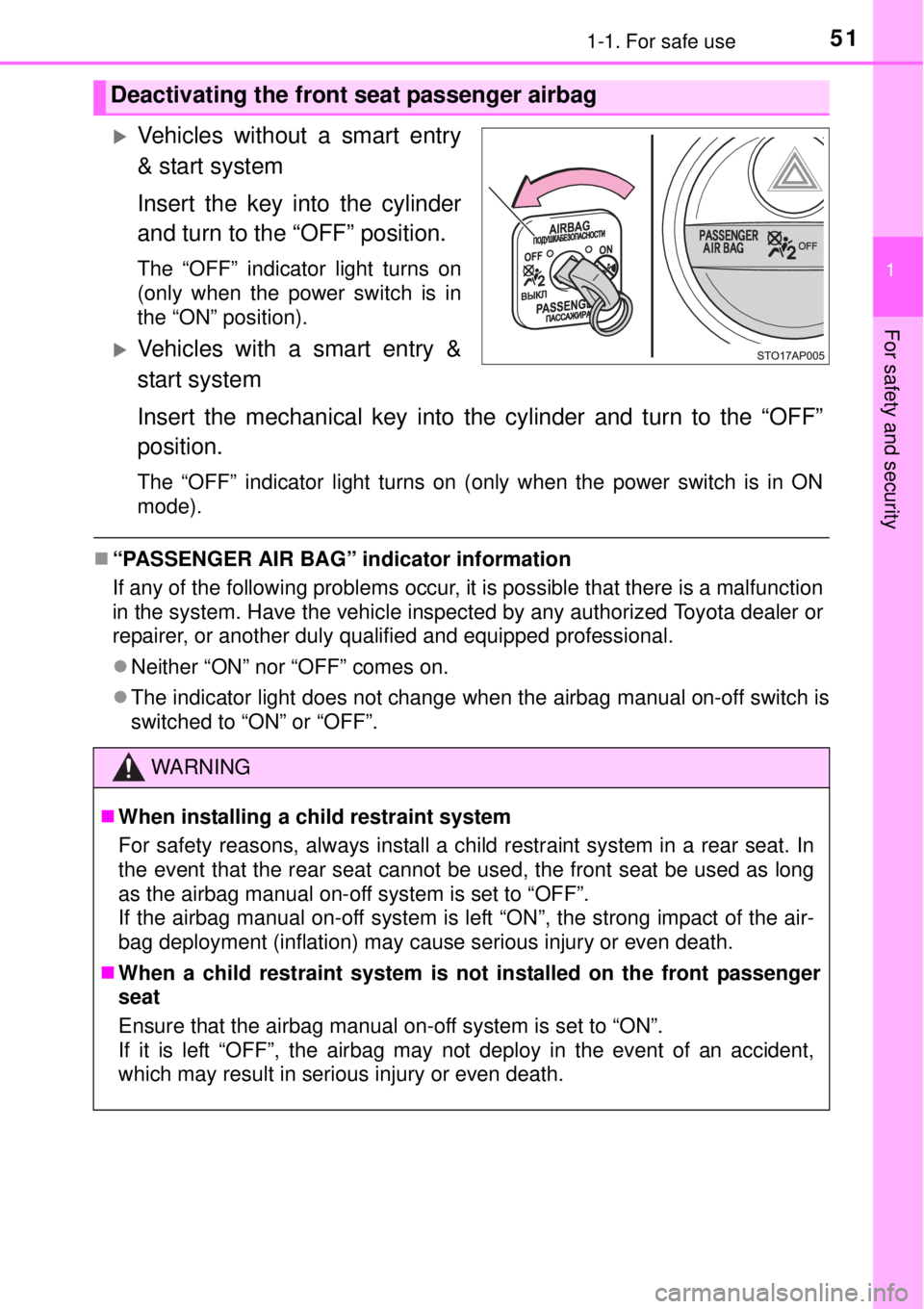
511-1. For safe use
1
For safety and security
Vehicles without a smart entry
& start system
Insert the key into the cylinder
and turn to the “OFF” position.
The “OFF” indicator light turns on
(only when the power switch is in
the “ON” position).
Vehicles with a smart entry &
start system
Insert the mechanical key into the cylinder and turn to the “OFF”
position.
The “OFF” indicator light turns on (only when the power switch is in ON
mode).
“PASSENGER AIR BAG” indicator information
If any of the following problems occur, it is possible that there is a malfunction
in the system. Have the vehicle inspected by any authorized Toyota dealer or
repairer, or another duly qualified and equipped professional.
Neither “ON” nor “OFF” comes on.
The indicator light does not change when the airbag manual on-off switch is
switched to “ON” or “OFF”.
Deactivating the front seat passenger airbag
WARNING
When installing a child restraint system
For safety reasons, always install a child restraint system in a rear seat. In
the event that the rear seat cannot be used, the front seat be used as long
as the airbag manual on-off system is set to “OFF”.
If the airbag manual on-off system is left “ON”, the strong impact of the air-
bag deployment (inflation) may cause serious injury or even death.
When a child restraint system is not installed on the front passenger
seat
Ensure that the airbag manual on-off system is set to “ON”.
If it is left “OFF”, the airbag may not deploy in the event of an accident,
which may result in serious injury or even death.
Page 52 of 464
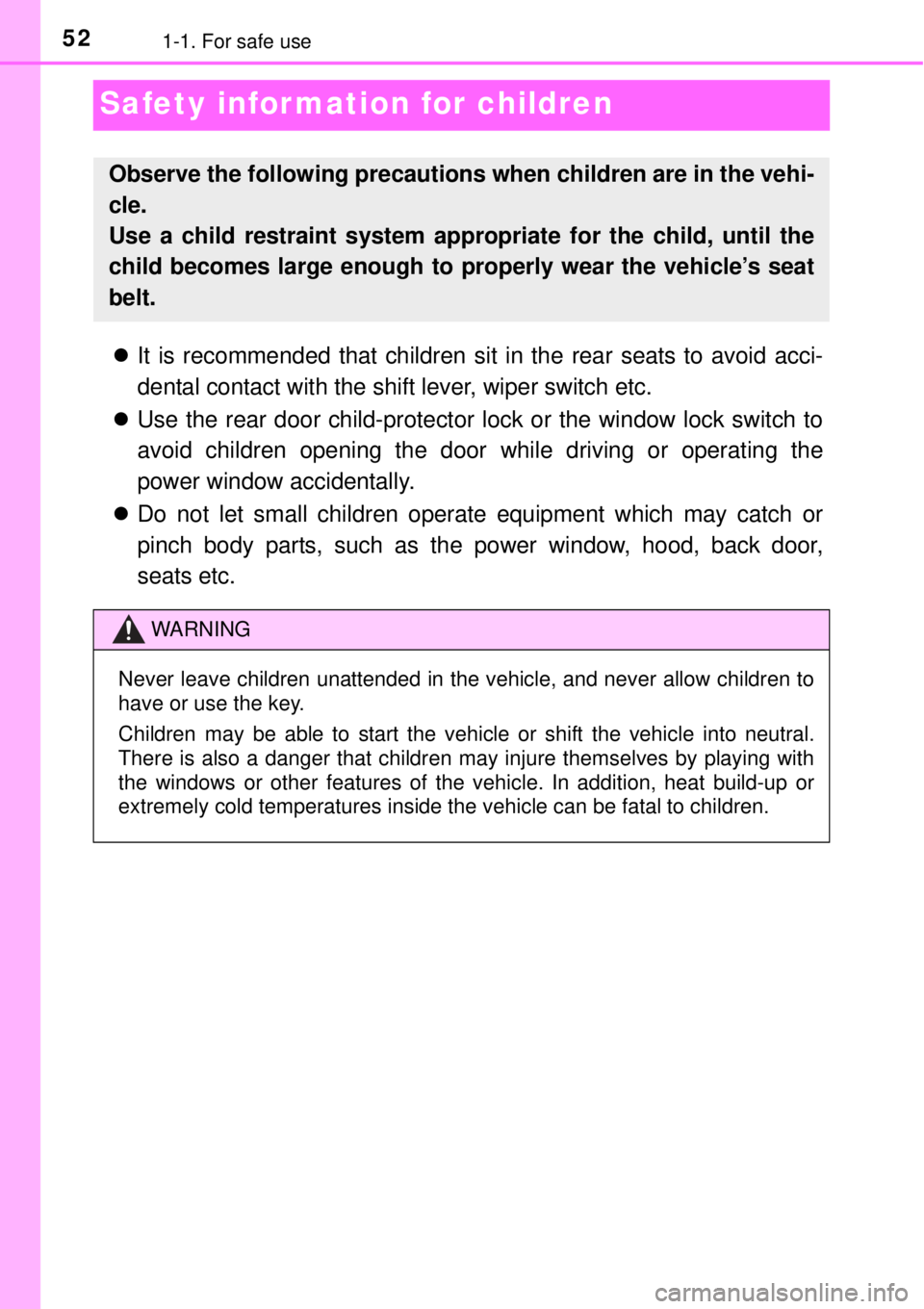
521-1. For safe use
Safety information for children
It is recommended that children sit in the rear seats to avoid acci-
dental contact with the shift lever, wiper switch etc.
Use the rear door child-protector lock or the window lock switch to
avoid children opening the door while driving or operating the
power window accidentally.
Do not let small children operate equipment which may catch or
pinch body parts, such as the power window, hood, back door,
seats etc.
Observe the following precautions when children are in the vehi-
cle.
Use a child restraint system appropriate for the child, until the
child becomes large enough to properly wear the vehicle’s seat
belt.
WARNING
Never leave children unattended in the vehicle, and never allow children to
have or use the key.
Children may be able to start the vehicle or shift the vehicle into neutral.
There is also a danger that children may injure themselves by playing with
the windows or other features of the vehicle. In addition, heat build-up or
extremely cold temperatures inside the vehicle can be fatal to children.
Page 57 of 464
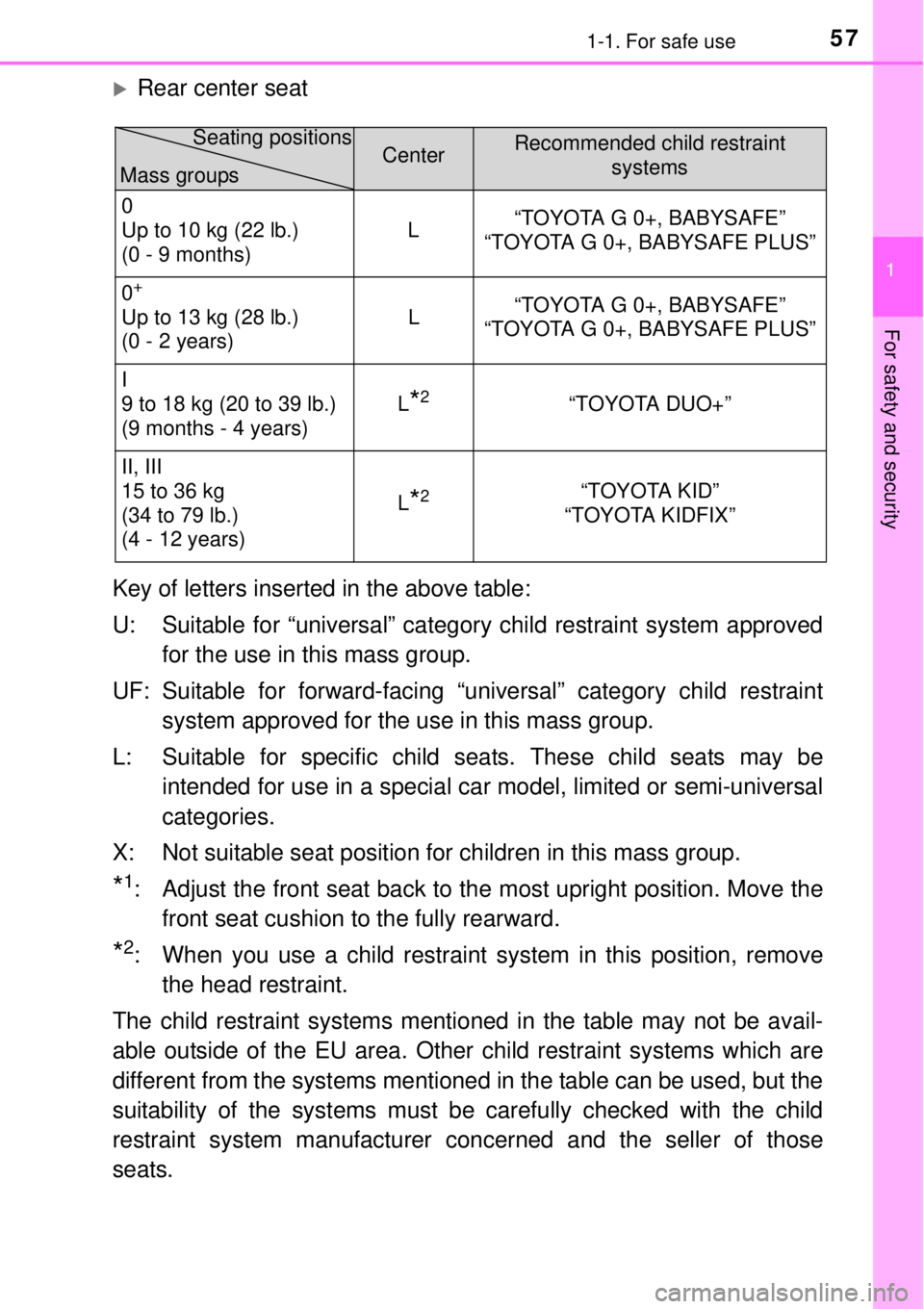
571-1. For safe use
1
For safety and security
Rear center seat
Key of letters inserted in the above table:
U: Suitable for “universal” category child restraint system approved
for the use in this mass group.
UF: Suitable for forward-facing “universal” category child restraint
system approved for the use in this mass group.
L: Suitable for specific child seats. These child seats may be
intended for use in a special car model, limited or semi-universal
categories.
X: Not suitable seat position for children in this mass group.
*1: Adjust the front seat back to the most upright position. Move the
front seat cushion to the fully rearward.
*2: When you use a child restraint system in this position, remove
the head restraint.
The child restraint systems mentioned in the table may not be avail-
able outside of the EU area. Other child restraint systems which are
different from the systems mentioned in the table can be used, but the
suitability of the systems must be carefully checked with the child
restraint system manufacturer concerned and the seller of those
seats.
CenterRecommended child restraint
systems
0
Up to 10 kg (22 lb.)
(0 - 9 months)L“TOYOTA G 0+, BABYSAFE”
“TOYOTA G 0+, BABYSAFE PLUS”
0
+
Up to 13 kg (28 lb.)
(0 - 2 years)L“TOYOTA G 0+, BABYSAFE”
“TOYOTA G 0+, BABYSAFE PLUS”
I
9 to 18 kg (20 to 39 lb.)
(9 months - 4 years)L
*2“TOYOTA DUO+”
II, III
15 to 36 kg
(34 to 79 lb.)
(4 - 12 years)L
*2“TOYOTA KID”
“TOYOTA KIDFIX”
Mass groupsSeating positions